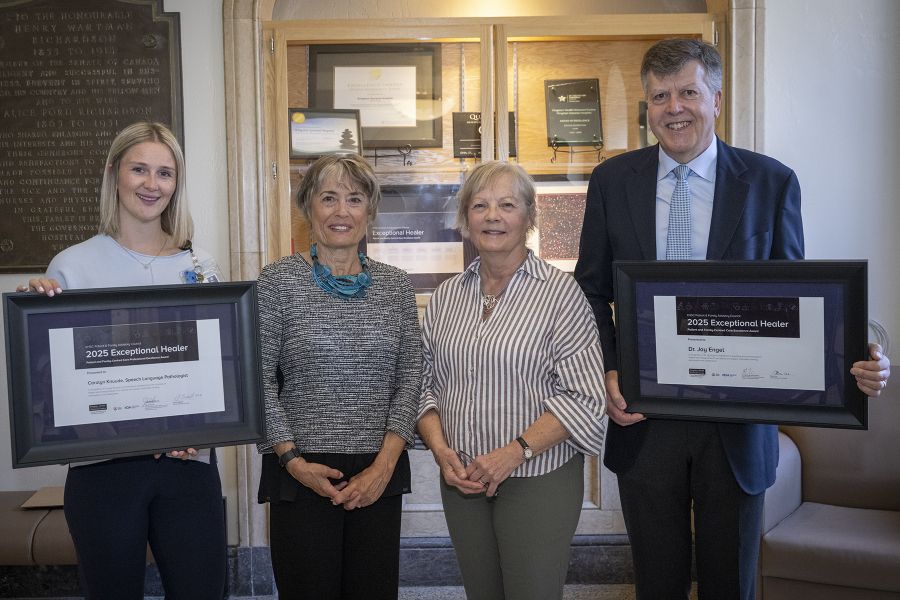KINGSTON, ONTARIO - Work is now underway at Kingston Health Sciences Centre’s (KHSC) Kingston General Hospital (KGH) site to uncover a sad chapter in world history. An archeological firm has begun the process of unearthing and relocating the remains of Irish immigrants who contracted and died of typhus while escaping Ireland’s Great Famine in 1847.
An estimated one million Irish died in what is known as the Great Irish Famine (also known as the Great Irish Hunger and Great Irish starvation) and another two and a half million were forced to leave their homeland between 1847 and 1852. An estimated 1,400 Irish immigrants died shortly after arriving in Kingston and were buried on the grounds of Kingston General Hospital (just to the west of KGH’s original Watkins wing.)
The work to relocate the individuals buried at KGH is an integral part of KHSC’s KGH site redevelopment project, which will see the demolition of a number of older buildings, to make way for the construction of a new patient tower. The new tower will house new operating rooms, a new emergency department, laboratories, labour and delivery department, neo-natal intensive care unit and two inpatient floors.
“While our redevelopment project is essential for KHSC to continue to meet the highly-specialized needs of patients from across southeastern Ontario, we recognize the level of care and sensitivity required to relocate a burial site such as this,” says Krista Wells Pearce, KHSC’s vice-president of Planning. “We have been working closely with representatives of the local Irish community as well as with leadership from the Anglican, Presbyterian and Catholic churches, to not only bless the site before the work began, but to respect the dignity, faith and culture of those who were buried here nearly 175 years ago.”
In 1847, during the Great Famine, landlords were made responsible by the British government for the welfare of their Irish tenants. So, many landlords forced tenants off the land and aboard ships destined for North America. Irish citizens weakened by hunger and infected with typhus, were forced to come to Canada on these overcrowded ships. The close quarters and poor ventilation onboard, contributed to the quick spread of the disease. Many died before ever arriving in Canada, giving their vessels the grim nickname “coffin ships.”
“Around 50,000 Irish immigrants came to Kingston and about 1,400 men, women and children died of typhus and were buried at KGH,” says Tony O’Loughlin, Founder & President of Kingston Irish Folk club and the Kingston Irish Famine Commemoration Association. “At the time, KGH was a small, seasonally operated hospital and had fewer than 50 beds. It was totally overwhelmed by the large numbers of critically ill Irish patients arriving that summer.”
Thomas Kirkpatrick, Kingston’s first mayor, and the local Board of Health set up large ‘fever sheds’ mainly along the waterfront near Emily Street, however, these were insufficient to meet the demand and filled quickly. In an effort to control the spread of the disease, the deceased were buried as quickly as possible. Remains were brought nightly by death carts to the grave site on the grounds of KGH.
“At that time the majority of citizens in Kingston were Irish and many brought the newly arrived sick individuals into their homes leading to further spread of the disease. About 300 Kingstonians also died while trying to help the newly arrived Irish. Those individuals were buried in Kingston’s upper cemetery in what is now McBurney Park. Mrs. Martin (who held the position of first Matron at KGH) and her daughter, as well as Sister Mary Magorian, a member of Religious Hospitallers of St. Joseph who served Hotel Dieu Hospital are among those that contracted and died from typhus while helping the Irish,” says O’Loughlin.
A small number of the remains, along with a large statue to mark the sacred ground, were moved to St. Mary’s cemetery during hospital expansion in 1966. However many individuals remain interred at KGH, including underneath a parking lot and under and around several buildings. Historic plaques were erected on the site, but they include incorrect information stating all of the remains had been moved from KGH grounds in 1966. The confirmation that the burials remain on the site was done by Ground Truth Archaeology in 2020.
“Working with Infrastructure Ontario, we’ve hired a Canadian archeological firm, ASI, who bring expertise in cultural heritage conservation and experience working on both hospital and Irish famine projects,” says Wells Pearce. “They are treating this work with the respect it deserves, not only in honour of those that are buried here, but also from a greater historical perspective. They have told us that the excavation and respectful study of the remains is a unique opportunity, unprecedented in Canada, to learn more about their lives during and prior to the events of 1847.”
As part of their work, ASI has also consulted with representatives of local Indigenous communities before starting their work.
The remains of the Irish will be re-interred in a local cemetery in the future. Kingston Health Sciences Centre has also committed to creating a public monument to these individuals once construction of the new patient tower is complete. It is expected that the excavation work will continue through the summer and into late autumn.
MEDIA INQUIRIES TO:
John Pereira
Strategic Communications Advisor
Kingston Health Sciences Centre
Cell: 613-217-4067
Email: @email
Tony O’Loughlin
Founder and President,
Kingston Irish Famine Commemoration Association and Kingston Irish Folk Club
613-389-0754



